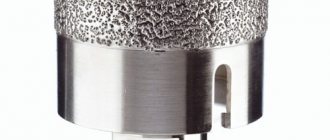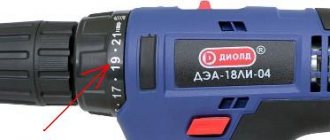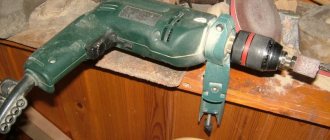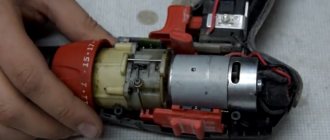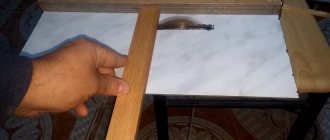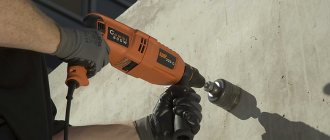How to drill a concrete wall correctly
The process of renovating an apartment includes a huge amount of work related to creating holes in the walls: for this purpose, you use tools of various designs and power. Probably craftsmen and others who are going to carry out repairs without the help of others want to find out how to drill a concrete wall with an ordinary drill and whether this is even possible. For such work, a hammer drill is usually used; unfortunately, it is rarely suitable for this purpose; in addition, if the tool is to be taken, then its price is even higher than that of a drill.
How to make a hole for a screw?
Hold the drill at the angle required to drive the drill and drill a hole with a depth comparable to the length of the screw shank. Carefully remove the drill bit. Insert the screw. Once the pilot hole is drilled, you can begin screwing in the screw.
Interesting materials:
What is the name of Sberbank today? What is a family without a father called? What is the middle of a flower called? What is the name of the Septum nose ring? What is the name of the gray-violet color? What is the name of the shepherd's hat? What is the name of the ball where they find out the gender of the baby? What is the name of the balloon with water? What is the name of the glass ball? What is the wool fabric for coats called?
How to save on a hammer drill and drill a concrete wall with a regular drill?
Many people live in houses with concrete walls, and when it comes to making a hole in them, they face serious difficulties.
Don’t despair or be upset if you didn’t manage to hang a shelf, lamp or cabinet right away, read our recommendations and everything will work out.
There are several options with which you can drill through a concrete wall yourself.
Industrial methods of dust protection
Vacuum dust collector
This device comes in two types:
- Mounted on a wall or ceiling - under the influence of suction force, it reliably “sticks” to any surface, even textured, and stays there as long as the vacuum cleaner is turned on. It has a hole in the middle through which a drill or crown passes (by the way, the diameter of the hole can vary, but for household needs 6–7 cm is usually enough).
- Mounted on a drill or drill - initially placed as close as possible to the drill head, and as drilling moves towards the body. The disadvantage of such dust collectors is that debris can still spill onto the floor, albeit in small quantities. However, one cannot fail to mention their advantage - such devices can be used even if you have to drill into a wall in hard-to-reach places.
By itself, such a dust collector will be a useless toy. A prerequisite for its operation is the presence of a powerful vacuum cleaner connected to a special connection. You can drill once or twice using the same vacuum cleaner that is used to clean the apartment, but for regular use it’s worth getting a “Rocket”, “Whirlwind” or “Buran”. The fact is that fine dust seeps through the filter system and settles in the engine. Modern specimens cannot withstand long and burn out, but the old Soviet monsters are almost indestructible.
We recommend: How to glue drywall to a concrete or brick wall
Self-adhesive bags
They have a number of advantages:
- They are relatively cheap, so they are ideal for those who use a hammer drill only occasionally.
- Doesn't take up space in your toolbox.
- Transparent, so they do not interfere with the view.
- Completely prevents dust from getting on the floor.
- There are options for both a regular drill and a hole saw.
- Despite the fact that they are considered disposable, after the first use they retain their adhesive properties and can be reused (you just need to empty out the debris that has accumulated inside).
The only disadvantage of such packages is that they are completely unsuitable for drilling ceilings and other horizontal surfaces.
Safety regulations
First of all, you should know that concrete dust (like asbestos dust) is very harmful to the respiratory system. If you drill without personal protective equipment, you can develop respiratory diseases in a very severe form. Protection is also needed for the eyes, since dust getting under the conjunctiva and on the cornea causes very painful inflammation, after which you can easily lose your vision. Therefore, when working, be sure to remember to use goggles, a respirator, special clothing and, if possible, a helmet. It is also worth purchasing a face shield. The thing is very convenient, and it can be used together with glasses, and is strong enough so that nothing unnecessary will fly in.
When carrying out this type of work, in accordance with safety regulations, there should be no unauthorized persons without personal protective equipment within a radius of 2.5 meters from the object. Also, to work at a height of more than 1.5 meters with a hammer drill, you need a solid foundation - scaffolding or sawhorses. A stepladder or ladder is not an option. Before starting work, carefully study the electrical and gas communications diagram. Pay special attention to whether there is reinforcement in the wall. To make sure, “ring” the wall. However, not a single device gives a 100% guarantee that there are no wires in the wall, especially under decorative trim. Therefore, if you are not sure, do not drill.
Which attachments to choose?
Before drilling a hole in a concrete wall, you need to select a nozzle of the appropriate design. The following types are used for work:
- Impact-type toothed bits designed for drilling. When working with concrete, it is recommended to use varieties made from individual soldering teeth, made from the most durable metal alloys. Many bits are equipped with SDS tails for installation in a drill with a keyless chuck. Drills are well suited for concrete walls, however, upon contact with metal they can begin to collapse, so before drilling into a reinforced concrete wall, you need to check that there is no reinforcement used for reinforcement at the work site.
- Diamond bits, which are designed for hammerless drilling of holes. Such nozzles are more modern; with their help, it is easier to make a hole in a concrete wall. The edge of the crowns has an abrasive structure and special cutouts; during production it is processed by spraying diamond chips or corundum. Before making a hole in the wall, you only need to select the desired length of the nozzle: in everyday life, varieties with a diameter of up to 100-120 mm are used, in professional work larger crowns are used. A distinctive feature is the ability to drill without the risk of damaging the fixture with fittings.
- KS-crowns, which have a cutting edge with crystalline diamond particles. These bits are used for most hard walls, including drilling into concrete slabs, exterior walls and masonry structures.
Before working with drilling equipment, you need to select a nozzle suitable in composition, thickness and length
Before drilling into a load-bearing wall or partition, you need to make sure that wires or cables, if any, will not be touched during the work.
Drill selection
The type of material and holes determines which drill to use to drill a concrete wall. The correct choice will increase the quality, accuracy of the result and the integrity of the nozzle. The stores offer special drills for various types of materials: wood, concrete, metal. The features of drills for concrete come down to the triangular shape of the tip and the application of a carbide composition to the tip. A conventional drill with a Pobedit drill bit can be used to crush concrete without tearing the material.
If the process stalls at the stage of drilling concrete, holes are drilled with a hammer drill or the impact mode is turned on. The only drawback of the hammer drill is the large holes, diameter 13 mm. Dense areas can be easily overcome with a mechanical punch and hammer. The area should be punched until the material softens. Then continue drilling the hole.
To drill several holes on concrete, special soldering tips are used on the nozzle:
- pobedite tip;
- universal drills, but they should be cooled regularly;
- Diamond drills for concrete are a relatively expensive material, but durable.
While drilling, make sure that there is no uncharacteristic sound of contact with metal. If you hit the reinforcement in the wall, it is important to complete the procedure while the nozzle is still sharp.
Choosing a drill bit for a drill
Correctly drilling concrete with reinforcement can be done in 3 stages:
- Reach the metal layer with a pobedite tip.
- Install a drill for metal - the reinforcement is soft and should be drilled out easily.
- Continue working with the concrete drill.
Hammer without a crown
If you don’t have a crown, but you have a long way to go after it or there’s nowhere to go (it’s night, and you’re in the village, building a dacha with your father-in-law), then there is an option to do without it, just with a hammer drill. However, this “pleasure” is not for the faint of heart, especially if instead of a hammer drill there is a regular drill without impact mode.
Just like with the crown, we mark the circle, drill in the center and according to the marking of the hole, simultaneously sending the father-in-law to the garage for a hammer and chisel. After the circle, we drill as many holes as possible inside the future socket box. After all the manipulations and a short smoke break, we begin to gouge out a hole with a chisel and hammer. The process is long, but it is an option, especially if you are limited in tools and time for repair work.
Through holes up to three cm
For repairs you will need a small set of tools and materials:
- Sharp knife;
- Sealant or PVA glue;
- Any material at hand to fill the space for the holes. This could be crumpled paper or a piece of foam left over from the packaging of received home appliances;
- putty;
- Sandpaper;
- Putty knife.
Before filling a drywall hole of this size, you need to prepare the surface:
Clean the edges so that a smooth inner surface emerges without crumbling bits and pieces of paper; Carefully go over the inner edge of the cleaned hole and the area around it with primer at a distance of 5-10 cm; The prepared lumps of paper or polystyrene are smeared on the sides with glue and the hole is sealed with it. You need to make sure that the edges of the homemade cork do not protrude above the plane of the wall; After the glue has dried, seal the hole with putty. Subsequent steps depend on the type of decorative wall covering: the color requires careful alignment, since a small flaw is noticeable on the painted surface
Therefore, another layer of putty and careful smoothing with fine sandpaper may be useful.
Subsequent steps depend on the type of decorative wall covering: the color requires careful alignment, since a small flaw is noticeable on the painted surface. Therefore, another layer of putty and careful smoothing with fine sandpaper may be useful.
Video description
This video shows how to drill a hole with a hammer drill with a diamond bit:
Diamond drilling is done in 2 ways - dry and wet. In the second case, when drilling, water constantly flows onto the working surface. It cools the drill and reduces noise; dust settles in it. However, if electrical wiring runs nearby or constant access to water is not possible, the dry method is used.
Diamond drilling produces smooth holes Source kas.kz
Drilling technology
When analyzing the topic of how to drill a concrete wall with a conventional drill, you should understand that for successful drilling you need to take into account certain nuances:
- If you need to get a deep hole with a large diameter, it is better to drill it with a hybrid drill and hammer drill.
- When making a hole for a dowel, you need to drill to a depth exceeding the fastening element. Then this reserve will become clogged with dust when driving the dowel.
- It is recommended to start drilling without turning on the impact mode, setting the tool to medium speed. After deepening the drill, the speed is sharply increased, while simultaneously adding the striker mode. By doing this, you eliminate the possibility of the drill moving due to vibration.
- When working, a lot of dust invariably appears. It is advisable to turn on the vacuum cleaner, then the flying particles will be sucked up by it.
- When clamping the drill, you need to insert its shank all the way.
- A low-power drill is used for no longer than a quarter of an hour. Then take a ten-minute break.
- If you wet the bit before drilling, the wear on its cutting tip will be reduced.
- If a through hole is being made, reducing the speed at the final stage will help prevent concrete from spalling on the opposite side.
When the drill is jammed in the monolith, you cannot remove it by hitting it with a hammer or trying to loosen it with pliers. You can remove the stuck part by drilling a small hole nearby.
The procedure is successfully completed when the final goal is achieved, the instrument remains undamaged.
How to drill a concrete wall using tools?
To drill a hole in a concrete wall, you will need a power tool. It is most convenient to use a hammer drill for this purpose, but not every owner has one. The reason is the price of the tool, which makes it unprofitable to purchase it to perform work 1-2 times in six months. More often, for household work, they buy a simple impact drill.
If you are just getting ready to buy a drill, you need to take into account some nuances when choosing it. When considering the technical characteristics, pay attention to models with a power of at least 600 W, revolutions - 2500 per minute. It is necessary to be able to regulate the speed from the lowest to the highest value. Choose a tool with a quick-release chuck and reverse rotation.
It is good to use not a conventional drill, but one with a hammer function, to make holes in a concrete wall. Of course, the work will not be the same as using a hammer drill, but it will be much easier and faster. The reason is this: concrete and cement can easily withstand pressure, but can quickly collapse from dynamic impact. When drilling is done without impact, the cutting edge of the drill can barely grip the material. This leads to slower operation and strong heating of the drill. When working with an impact drill, the drill chips off part of the material with the edge with each blow, this is similar to chiselling using a chisel.
To properly drill a hole in concrete, you need a carbide drill.
Its cutting edges can be made of pobedite or artificial diamond. Using pobedite drills, a hole is made to a depth of 10-15 cm. If greater depth is required, you cannot do without a drill. The drills are up to 100 cm long and can only be used with a hammer drill. Its cutting edges are rounded and not sharp (this increases their wear resistance). You can also use the drill for a drill equipped with a hammer drill function.
Drilling holes in the wall correctly: general rules and recommendations for what to drill
In order to correctly drill a wall, you need to take into account the material from which it is made, based on this you need to select a tool.
- When working, hold the tool correctly. For example, a drill should be held straight in your hands and enter the surface in a vertical direction;
- for convenience, use an additional handle;
- Depending on the surface material, select the necessary drills.
- concrete, stone, brick wall - use a carbide drill, usually a Pobedit one;
- metal – metal drill;
- tiles, ceramic tiles - special drills for these materials, sometimes they can be replaced with a drill for concrete with Pobedit surfacing;
- Chipboard, wood - for holes smaller than 10-12 mm, a metal drill is suitable; for larger ones, special wood drills are used.
Preparing for work
When working with power tools, first of all, you must follow the safety rules:
- Do not work with a faulty tool or if the cable is damaged, do not plug it into the mains. Handle it carefully so as not to damage it.
- To protect yourself in case you accidentally touch the wiring while working, before starting work you need to turn off the electricity and power the drill from a separate outlet in the switchboard. (By the way, there are not only corded drills, but also cordless drills.)
- If there is a hidden gas distribution in the house (which, by the way, is prohibited by all regulations), it is also better to turn off the gas during the work - out of harm’s way.
- Always insert the drill bit into the chuck until it stops; if you need a deeper hole, use a longer drill bit.
- If the chuck does not hold the drill well, replace it! Is it dangerous.
- Sleeves or gloves should not hang loose to prevent them from accidentally getting wrapped around moving parts. Do not hold the cartridge with your hand during operation.
- If you need to drill a hole at height, be careful. Do not stand on unstable stools, stepladders, etc. Do not drop the instrument.
- You must know the structure of the tool you are working with well. Read the instructions and remember the location of all the buttons.
- When drilling concrete, small fragments fly out from under the drill or auger at high speed, so be sure to wear safety glasses.
- If you work with percussion instruments for a long time, you should also take care of your hearing and respiratory organs. Don’t be lazy to get a respirator and earplugs.
Now you can prepare the drills for work. Adjust the cutting depth of holes in concrete - if it is adjustable. If not, just make a mark on the drill bit.
It is also important that the drill does not deviate to the side and is on the same axis with the tool. And even if you need to drill a large hole, it is better to use a smaller drill first.
Make the depth 5 mm larger than necessary - it will still be less because dust will partially clog the hole.
Finally, if the drill bit is dirty from last time, it should be wiped with a rag for better drilling.
Using an awl and screws
An awl is a universal tool that can help in many repair situations, including this one.
First you need to take a pencil, take measurements and mark the place where you want to make a hole. To begin with, a simple point will be enough, since the awl itself is thin. If you don’t have an awl at hand either, you can try to carry out the same operation using a nail, carefully driving it in with a hammer.
You need to use a thin or medium nail so as not to damage the wall surface. You need to drive it in completely, because then it will be difficult to pull it out. The length of the nail directly depends on the required depth of the hole, but initially the hole should be made somewhat shorter.
Then this point on the wall must be punched to the desired depth. The latter directly depends on your purposes, for which the hole is intended. This is where the work with the awl ends, then self-tapping screws are used.
Since the thickness of the awl is minimal, it is not capable of making a wide hole, but it was this that paved the way for us to proceed further. Then we take the thinnest self-tapping screw, which we screw into the existing hole and pull it back out.
Next, you will need a larger self-tapping screw, with which you need to do exactly the same manipulation. Instead of self-tapping screws, you can also use large-diameter screws.
Thus, it is possible to obtain a hole whose diameter does not exceed the diameter of the largest self-tapping screw or screw. If you need a larger hole, then you should resort to using a drill.
It must be inserted into an existing hole and turned using pliers, while pressing on the drill itself with your hand from above.
Source
Advice from professionals
Before you decide what to drill into concrete walls with and start working, it is worth noting the following tips:
- if the diameter of the hole exceeds 12 mm and the depth is 10-11 cm, it is better to use a hammer drill or a hybrid device (drill-hammer);
- if holes are made for plastic dowels, the depth may be more than just the size of the fastening element by 7-10 mm, since concrete dust and small particles of stone remain inside;
- It is recommended to start work at low speeds so that the nozzle does not move due to excessive torque, and the impact mode is turned on when the drill goes 2-4 mm deep;
- dust that appears during drilling can be removed with a vacuum cleaner; it is better to do this continuously, stopping the drill from time to time and cleaning the hole from concrete particles;
- Be sure to follow safety precautions during the work: you need to wear gloves to eliminate the risk of the handle slipping and safety glasses so that the crumbs do not get into your eyes or even damage the mucous membranes.
Drill size chart for dowels
Almost always, a concrete wall is drilled with a hammer drill, without a drill. When, as part of the repair, it is necessary to make no more than 15-20 holes or the wall is made of foam concrete, using a drill is the best choice, which will save time and money.
Before punching a hole, you need to make sure that there is no wiring in this place, and check whether the attachment is suitable for such work (how well you can choose the studio, what kind of drill the drill will be equipped with, depends on the duration and efficiency of the work). When deciding how to drill a wall, you need to find out about pobedite bits: with such a drill using a drill, you can easily punch a hole up to 10-12 cm deep.
Source


